About GRE
The Graduate Record Examinations (GRE) General Test is a standardized computer adaptive test (CAT) test that graduate schools use to evaluate candidates. Over one thousand graduate programs around the world require applicants to submit GRE scores in order to be considered for admission. Many business schools are demanding the GRE test score rather than the GMAT, especially for Masters programs such as Financial Engineering. In addition, the GRE is often used to help determine whether a student is awarded graduate fellowships or graduate research or teaching positions. Statistics show that a combination of GRE score and undergraduate grade point average is generally a better predictor of first-year graduate school grades than is undergraduate grade point average alone.
Test Format
The GRE is a three hour forty minute computer adaptive test (CAT). There are three main sections in the test, as summarized in the table below.
| Section |
|
Time |
| Writing Sections |
Analysis of Argument Essay
Analysis of Issue Essay |
30 minutes
30 minutes |
| Quantitative Sections |
Section 1 (approximately 20 questions)
Section 2 (approximately 20 questions) |
35 minutes
35 minutes |
| Verbal Sections |
Section 1 (approximately 20 questions)
Section 2 (approximately 20 questions) |
30 minutes
30 minutes |
| Unscored section |
Either one verbal or quantitative section |
30 minutes |
The Analytical Writing section is always administered first; the other five sections of the test may appear in any order. There is a one-minute break between each section, and an optional ten-minute break after the third section.
Since there is no way to identify which Verbal or Quantitative section is unscored, students should treat each section as though it were being scored. Some students may receive an identified research section instead of an unscored Verbal or Quantitative section. A research section (if included) is always the final section of the test; questions on a research section do not count toward the test-taker’s score.
The Analytical Writing Section
The Analytical Writing section measures a student’s ability to critically assess an argument and effectively communicate ideas in print. There are two essays on this section:
Present Your Perspective on an Issue (the Issue Task) – a test-taker must construct a persuasive argument outlining his or her perspective on a statement, issue, policy position, or course of action.
Analyze an Argument (the Argument Task) – a test-taker must evaluate a particular line of reasoning (e.g. – point out where an argument is strong or weak). The Argument task does not ask for a test-taker’s opinion but for an analysis of the argument.
The essay topics are presented one at a time. Students have 30 minutes to complete each essay and are not allowed to add any extra time remaining at the end of one essay to the time allotted for the other essay. For example, if you finish the Issue task in 20 minutes, you will still have only 30 minutes to complete the Argument task. Thus, the best strategy is to use the entire time allotted for each essay to proofread and make editorial adjustments.
Students who take the computer-based test must type their essays using a general word-processing program. The program has basic cut-and-paste features, but does not allow students to check spelling or grammar.
The Quantitative Sections
The Quantitative sections measure a student’s ability to solve mathematical problems and interpret data presented in graphical form. These sections contain four distinct question categories:
- Multiple-Choice (select one answer choice) – these questions present a mathematical problem and require students to select exactly one correct answer choice from among the five presented.
- Multiple-Choice (select one or more answer choices) – these questions present a mathematical problem that may have more than one solution among the answer choices; students must select each answer choice that applies. Students do not receive credit unless they select all and only those answer choices that are correct.
- Numeric Entry – students must type the answer to a mathematical problem into the answer box provided.
- Quantitative Comparison – students must select the answer choice that accurately describes the relationship between the quantity in column A and the one in column B:
(A) always means that the quantity in column A is greater;
(B) always means that the quantity in column B is greater
(C) always means that the two quantities are equal; and
(D) always means that there is not enough information to determine which quantity is greater
Questions from all four categories are intermixed throughout each Quantitative section.
Each question type covers at least one of four basic areas of mathematics: arithmetic, algebra, geometry, or data analysis. Data analysis questions require students to interpret charts or graphs and typically appear in clusters of three or four, all of which pertain to the same graphical data. There is no trigonometry or calculus on the GRE, nor are there any questions that require mathematical knowledge beyond what most American students learn in the first two years of high school.
Students who take the computerized version of the test have access to an on-screen calculator for the Quantitative sections. Students who take the paper version have the option of using a calculator provided at the test site.
The Verbal Sections
The Verbal sections of the GRE measure the ability to understand and analyze written material and the ability to recognize and conform to the conventions of standard written English. These sections contain three distinct types of questions:
- Reading Comprehension
- Text Completion
- Sentence Equivalence
Questions of all three types are intermixed throughout each verbal section. The GRE has eliminated Antonym and Analogy questions.
Reading Comprehension
Reading comprehension on the GRE consists of a passage of up to 350 words, followed by a cluster of at least two questions that pertain to that passage. These questions frequently require students to summarize the author’s main point, strengthen or weaken an argument made in the passage, or identify what must be true based on the facts presented.
Reading Comprehension questions fall into three distinct categories
- Multiple-Choice (select one answer choice) – students must select the one correct answer choice from among the five provided.
- Multiple-Choice (select one or more answer choices) – students must select at least one correct answer choice from among the three answer choices provided; no credit is given for incomplete or partially incorrect answers.
- Text Selection – students must highlight the portion of the passage that meets the description provided.
Each of these question categories tests the ability to read, absorb, and analyze written information.
Text Completion
These questions consist of a short passage that contains one, two, or three blanks; each blank represents a word or short phrase that is missing from the passage. Students must select exactly one correct answer choice from among the three to five provided for each blank. A student does not receive credit for a Text Completion question unless he or she selects the correct answer choice for every blank in the passage.
Students must use contextual clues within the passage to determine which answer choice contains the word or words that most logically complete each blank. This question category tests the ability to recognize an author’s overall meaning or tone from the syntax of the written material. Success on these questions requires an understanding of the subtle shades of meaning that differentiate similar words.
Sentence Equivalence
These questions consist of a single sentence that contains a single blank. Students must select the two answer choices from among the six provided that both (1) fit coherently into the sentence, and (2) produce sentences that are equivalent in meaning. Like Text Completion questions, these questions measure the ability to determine overall meaning from contextual clues. As with all multiple-selection questions on the GRE, students receive no credit unless they select all and only those answer choices that are correct.
How is the GRE scored?
An official GRE score report consists of three parts:
- A Verbal Scaled Score (on a scale from 130 to 170, in one-point increments)
- A Quantitative Scaled Score (on a scale from 130 to 170, in one-point increments)
- An Analytical Writing Score (on a scale from 0 to 6, in half-point increments)
The Verbal and Quantitative Sections
A test-taker’s final scaled score for the both the Verbal portion and the Quantitative portion of the GRE is based on two factors:
- the number of questions answered correctly within the time permitted
- the level of difficulty of the questions
Both the Verbal and the Quantitative portions of the test are section-level adaptive, meaning that a student’s performance on the first section of a type determines how difficult the second section of that type will be. The better a student’s performance on the first section, the more difficult the second section. Answering more difficult questions increases the potential for a higher scaled score.
The total number of questions that a student answers correctly on both sections of a given type is the student’s raw score for that portion of the test. Through a process called equating, which takes into account the difficulty of the questions and the raw scores for both the Verbal and the Quantitative portions are converted into scaled scores on the 130 – 170 scale.
Upon completing the test, students must decide whether to keep or cancel their scores. Students who choose to keep their scores can view their Verbal and Quantitative scaled scores immediately. Students who choose to cancel their scores do not have the opportunity to view those scores at any time.
Percentile Rankings for Examinees Who Tested Between July 1, 2007 and June 30, 2010
| Scaled Score |
Verbal |
Quantitative |
| 170 |
99 |
99 |
| 169 |
99 |
98 |
| 168 |
98 |
96 |
| 167 |
98 |
95 |
| 166 |
97 |
94 |
| 165 |
96 |
93 |
| 164 |
94 |
91 |
| 163 |
93 |
88 |
| 162 |
90 |
87 |
| 161 |
89 |
86 |
| 160 |
86 |
84 |
| 159 |
84 |
82 |
| 158 |
79 |
79 |
| 157 |
77 |
77 |
| 156 |
72 |
74 |
| 155 |
69 |
69 |
| 154 |
64 |
67 |
| 153 |
62 |
65 |
| 152 |
56 |
61 |
| 151 |
51 |
56 |
| 150 |
48 |
53 |
| 149 |
42 |
49 |
| 148 |
40 |
44 |
| 147 |
36 |
40 |
| 146 |
31 |
36 |
| 145 |
28 |
32 |
| 144 |
26 |
26 |
| 143 |
21 |
22 |
| 142 |
18 |
19 |
| 141 |
16 |
16 |
| 140 |
13 |
12 |
| 139 |
10 |
10 |
| 138 |
8 |
7 |
| 137 |
6 |
6 |
| 136 |
5 |
4 |
| 135 |
4 |
3 |
| 134 |
3 |
2 |
| 133 |
2 |
1 |
| 132 |
1 |
1 |
| 131 |
1 |
1 |
| 130 |
1 |
1 |
The Analytical Writing Section score
The Analytical Writing score is the average of a test taker’s score on the Issue task and his or her score on the Argument task. Essays are read and scored by two readers, each of whom gives the essay a grade on a scale from 0 to 6. If the two grades differ by less than one point, the average of those two grades becomes the final score for that particular essay. However, if the scores differ by more than one point, a third reader resolves the discrepancy and determines the final score. Once each essay has been assigned a final score, those two final scores are averaged and rounded to the nearest half-point. This number is the test-taker’s overall Analytical Writing score.
Since the essays need to be sent to readers in order to be graded, students cannot view their Analytical Writing scores on the same day that they take the test. Students who choose to keep their scores receive an official GRE score report via regular mail approximately two weeks after their test date. The Analytical Writing score is included in that score report.
The following table lists all of the possible Analytical Writing scaled scores and the percentile rankings assigned to each of them.
Analytical Writing Percentile Rankings for Examinees Who Tested Between July 1, 2007 and June 30, 2010
| Score Levels |
Percentage of Examinees Scoring Lower Than Indicated Score |
| 6.0 |
99 |
| 5.5 |
96 |
| 5.0 |
87 |
| 4.5 |
72 |
| 4.0 |
48 |
| 3.5 |
29 |
| 3.0 |
11 |
| 2.5 |
4 |
| 2.0 |
1 |
| 1.5 |
1 |
| 1.0 |
1 |
| 0.5 |
1 |
| 0 |
0 |
FAQ
How long will it take me to prepare for the GRE? 
This depends on so many different factors. If, for example, you come from a scientific/engineering background and therefore your mathematics is relatively strong you may not need too much extra tutoring to master the Quantitative section; however, you may find that you are in deep waters with regard to the Verbal section as your knowledge of key vocabulary or your reading skills are weak, and you have not written an academic essay. Or vice versa: you are an Arts major who was never very fond of or good at mathematics but suddenly you are confronted by the spectre of algebra, geometry and probability theory all over again. Generally speaking, we at the Tree Foundation find that given the above, the emphasis has to be placed on your weaker areas and thus the time devoted to tutoring distributed accordingly. In total, again generally speaking, 16 hours of intensive tutoring spread over a 2-3 month period is sufficient to put you in good stead for the GRE examination. Remember that for every one hour of tutoring you ought to dedicate at least 5 hours of studying to witness good results.
Do I have to write the essays and do my essay scores really matter? 
Yes, you do have to write the essays but dependent on the Masters program to which you applied, the emphasis placed on your essay scores will vary. If, for instance, you are applying for a Masters in Financial Engineering then the admissions officers will be more interested in your Quantitative section scores rather than seeing a 6/6 in your essay scores. If however you are applying for a Masters program that engenders a lot of language skills – History, Literature and so on – then there will be a heavy emphasis on your writing skills. Remember that good GRE scores should be included in your CVs and if you have good essay scores to boot then this will definitely be a plus for a future employer. Essentially, the purpose of the essay section is for the universities to discern that you have write competent, well-structured, academic essays.
How many times can I sit the GRE? 
Theoretically you could sit the GRE as many times as you like. However, it is best to prepare properly and sit the examination once. If you underperform then obviously you will go and resit. Again if you have prepared properly you should have numerous practice tests and therefore know pretty well how much you can attain in the respective sections. Also, do note that each and every time that you sit the GRE examination your score is recorded in a database and the universities to which you have applied can easily check to see how many times you have sat the test.
Which section is easier: the Quantitative or the Verbal? 
Well, that is an easy and a difficult question to address. Again it all depends on who you are and your relative strengths and weaknesses with regard to the two sections. On paper, it is more difficult to attain a high score in the Verbal section. Therefore, if your Verbal skills are weak from the outset it may be vain to believe that you can eventually get a 90% – you may achieve in 3 years but certainly not in 3 months. Therefore, our advice is to maximize your respective scores in the theoretical 3 to 4-month preparation period and move on.
Where can I sit the GRE test and how much does it cost? 
All the relevant information for location of test centers all over the world and the fees for the GRE test can be found here.
Important links
By far the most important link for all the relevant information regarding the GRE examination is to the official ETS GRE website.
Practice materials – Recommended textbooks
There are so many GRE books on the market that it is somewhat overwhelming trying to discern which are the most useful and most relevant to the actual real test.
 Obviously, it is a good idea to have the official ETS GRE textbook at hand. After all ETS is responsible for the design and the administration of the GRE. That does not mean, however, that you can depend on this book completely for your thorough and correct preparation for the GRE; certainly not. The depth and breadth and coverage of the material that is required for a decent score is not addressed in this textbook. Rather it proffers a good overview of the test and the language in which the test will be delivered.
Obviously, it is a good idea to have the official ETS GRE textbook at hand. After all ETS is responsible for the design and the administration of the GRE. That does not mean, however, that you can depend on this book completely for your thorough and correct preparation for the GRE; certainly not. The depth and breadth and coverage of the material that is required for a decent score is not addressed in this textbook. Rather it proffers a good overview of the test and the language in which the test will be delivered.
The tutors at the Tree Foundation have collated excellent notes and exercises that will prepare you more than adequately for an excellent score in the GRE test. Besides the notes and exercises that you will receive during the tutoring process, we would recommend that you also consider acquiring the following textbooks for additional practice:









